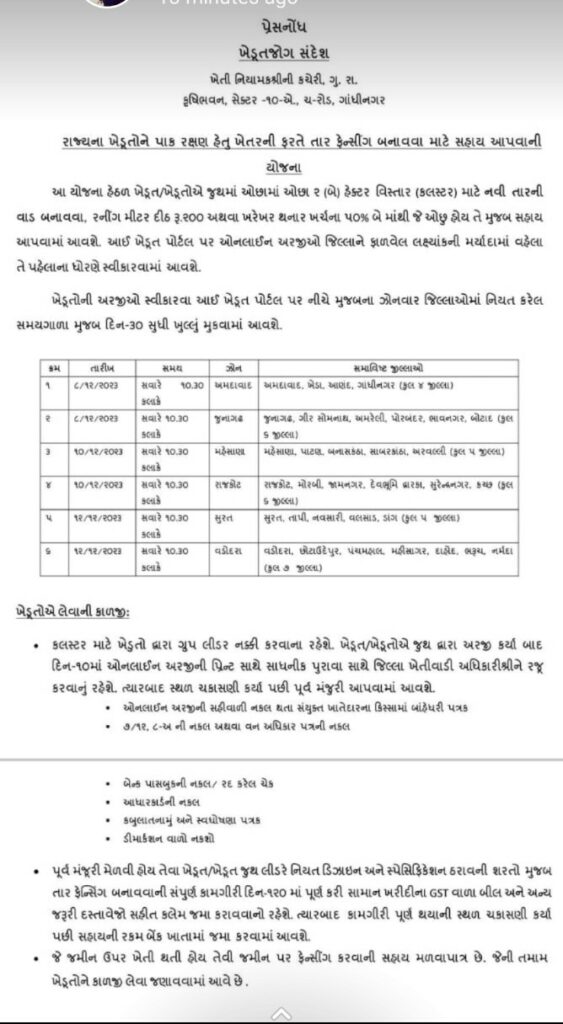The Department of Agriculture, Farmers Welfare and Cooperation of the Gujarat Government launched the “tar fencing yojana gujarat” on August 12, 2020, with the goal of preventing forest animals and cattle from damaging farmers’ standing crops. Yes, this program has been in place since 2005; however, the state government has regularly modified it to improve its usefulness and effectiveness in the farmers’ best interests. As a result, an increasing number of farmers are able to take advantage of this program.

Contents
Tar Fancing Yojana 2023
| Post Name | Tar Fancing Yojana |
| Category | Scheme |
| Portal | freshgujarat.com |
| Post Date | 05/12/2023 |
Tar Fencing Scheme 2023 | Tar Fencing Yojana Gujarat | Barbed Wire Fence Plan | Barbed Wire Fence Plan 2023 | Tar Fencing Yojana 2023 | ikhedut Portal | Gujarat Wire Fencing Scheme | i Farmer Scheme | ikhedut.gujarat.gov.in know complete information.|| Tar Fencing Yojana Gujarat 2023: Plan for barbed wire fence || Who will benefit from the scheme? || What are the specifications for a wire fence?
Tar Fancing Yojana Scheme |
The Hon. Chief Minister of Gujarat, Shri Vijaybhai Rupani, launched the “Sat Karan Khedoot Kalyan” program, which covers 80 areas over 33 districts in the state. The goals, advantages, and specifications of the Wire Fencing Scheme 2023 will all be covered in detail in this article.

Purpose of the Wire Fencing Scheme: |
The main goal of the Wire Fencing Scheme, which in Gujarat is also referred to as the Tar Fencing Yojana 2023, is to address the problem of crop damage in agricultural areas caused by cattle and wild animals. These are the scheme’s main goals:
- Crop Protection: The scheme aims to protect the agricultural crops of local farmers from the harmful effects of wild animals, such as wild boars and deer, as well as cattle. These animals can often enter farmlands and cause significant damage to standing crops, leading to financial losses for farmers.
- Minimize Agricultural Losses: By installing wire fencing, farmers can create a physical barrier that prevents wild animals and cattle from entering their fields. This helps minimize crop damage and agricultural losses, ensuring that farmers can harvest their crops without interference from these animals.
- Increase Farm Income: The scheme contributes to increasing the income of farmers by safeguarding their crops. When crops are protected, farmers can harvest and sell their produce without the fear of wildlife or cattle damage, leading to improved economic outcomes for farming households.
- Promote Agricultural Prosperity: Protecting crops from damage not only benefits individual farmers but also contributes to the overall prosperity of the agricultural sector in the region. Reduced crop losses can lead to increased agricultural productivity and food security.
- Livelihood Security: For many farmers, agriculture is their primary source of livelihood. Protecting their crops through wire fencing helps secure their livelihoods and ensures that they can continue to rely on agriculture as a sustainable means of income.
- Government Support: The scheme is a government initiative aimed at providing financial assistance to farmers for the installation of wire fencing. This support makes it more affordable for farmers to implement crop protection measures, reducing the financial burden on them.
Benefits of Wire Fencing Scheme |
The Wire Fencing Scheme (Tar Fencing Yojana) in Gujarat offers several benefits to farmers in the state. The primary objective of this scheme is to protect farmers’ crops from the damage caused by wild animals and cattle. Below are the key benefits of the Wire Fencing Scheme:
- Crop Protection: The scheme aims to minimize the damage caused by wild boars, deer, and other stray animals to standing crops. Wire fencing acts as a physical barrier, preventing animals from entering farmlands and destroying crops.
- Financial Assistance: Farmers who participate in the scheme are eligible to receive financial assistance to install wire fencing around their fields. This assistance is provided in two installments, with the first phase offering up to 50% subsidy or Rs. 100 per running meter (whichever is less), and the second phase providing 50% assistance based on the lower value between Rs. 100 per running meter and 50% of the total cost.
- Reduced Crop Losses: With effective wire fencing in place, farmers experience reduced crop losses due to wildlife interference. This leads to increased agricultural productivity and income for the farmers.
- Improved Livelihood: By safeguarding their crops, farmers can rely on agriculture as a more stable and sustainable source of livelihood. Reduced crop losses contribute to better financial stability for farming families.
- Online Application: The scheme offers the convenience of online application, making it easier for farmers to apply and access the benefits. This reduces paperwork and administrative hassles.
- GPS Inspection: The requirement for third-party GPS inspection ensures that the wire fencing is correctly installed and meets the necessary standards. This helps maintain the effectiveness of the scheme.
- Support for Young Farmers: The scheme may encourage collaboration among young farmers and farmer groups to collectively implement wire fencing projects.
- Protection for Rural Communities: The scheme benefits rural communities as a whole by protecting their agricultural resources. When farmers thrive, it contributes to the overall well-being of rural areas.
- Preservation of Natural Resources: By minimizing crop damage, the scheme indirectly contributes to the conservation of natural resources, as farmers are less likely to resort to harmful practices to deter wildlife.
- Government Commitment: The active involvement of the Gujarat Government in implementing the scheme reflects its commitment to increasing farmers’ income and supporting agriculture in the state.
In summary, the Wire Fencing Scheme in Gujarat not only provides financial assistance to farmers but also helps protect their crops and improve their overall livelihoods. It addresses the pressing issue of crop damage by wildlife and aims to enhance the prosperity of farming communities in the state.
Eligibility for Tar Fencing Yojana 2023: |
Eligibility criteria for the Tar Fencing Yojana 2023 in Gujarat are as follows:
- Applicant Type: The scheme accepts applications from individual farmers or groups of farmers. Both categories can apply for assistance under the scheme.
- Residency: Applicants must be residents of Gujarat state. The scheme is specifically designed to benefit farmers in Gujarat.
- Age Limit: There is no specific age limit mentioned for individual farmers or members of farmer groups in the eligibility criteria. However, applicants must meet other requirements.
- Financial Documents: Applicants need to provide relevant financial documents, including their bank account details, to be eligible for the scheme.
- Aadhaar Card: A copy of the Aadhaar card is a mandatory requirement for applying to the Tar Fencing Yojana. Applicants must submit a copy of their Aadhaar card along with other necessary documents.
- Land Ownership: Applicants must be landowners or have legal rights to cultivate the land where they intend to install the wire fencing. Land documents such as class 7/12 and class 8A records might be required to establish land ownership.
- Mutual Cooperation: The scheme encourages cooperation among farmers. If a group of farmers decides to participate and cooperate in implementing the wire fence scheme, they can collectively apply for assistance.
Announcement of Payment for Young Pioneers: |
The “Announcement of Payment for Young Pioneers” in the context of the Wire Fencing Scheme (Tar Fencing Yojana) in Gujarat refers to the notification or communication made by the relevant authorities regarding the disbursement of payments or subsidies to eligible beneficiaries, who are often referred to as “Young Pioneers” in this context. Here’s what this announcement typically entails:
- Beneficiary Notification: Farmers or farmer groups who have successfully applied for the Wire Fencing Scheme and met the eligibility criteria are informed about the approval of their applications. This notification is usually sent by the concerned government department or agency responsible for implementing the scheme.
- Payment Details: The announcement includes details about the amount of financial assistance or subsidy that each eligible beneficiary (Young Pioneer) will receive under the scheme. This assistance is provided to support the installation of wire fencing to protect crops.
- Payment Process: The announcement outlines the process for disbursing payments to the beneficiaries. It may specify the modes of payment, such as direct bank transfers or checks, and provide instructions on how beneficiaries can access the funds.
- Verification and Inspection: Beneficiaries are reminded that payments are typically made only after the completion of the wire fencing project and the verification of the installation. A third-party GPS inspection report and location verification are often required to ensure that the fencing is installed correctly.
- Cooperation and Collaboration: The announcement may encourage cooperation among farmers or farmer groups to actively participate in the implementation of the wire fencing scheme. Collaboration among farmers reinforces the support provided by the scheme and can lead to more effective protection of agricultural crops.
- Compliance with Guidelines: Beneficiaries are usually reminded to adhere to the specific guidelines and specifications provided for the installation of wire fences. This compliance ensures that the fencing meets the required standards for effectiveness.
Overall, the “Announcement of Payment for Young Pioneers” is a crucial step in the Wire Fencing Scheme, as it informs eligible beneficiaries about the financial assistance they will receive and provides guidance on the payment process, project completion, and compliance with scheme guidelines. This announcement helps ensure transparency and accountability in the implementation of the scheme.
Important Link |
| Download Tharav | Click Here |
| Apply Online | Click Here |
Specifications for Wire Fencing Scheme: |
- Proper installation of piles, with excavation measurements recorded as 0.40 m in each direction (length, width, and depth).
- Concrete piers used for the scheme shall be 2.40 m in length, 0.10 m in width, and height, with at least four strands, each not less than 3.50 millimeters in diameter.
- The distance between two pillars should not be less than 3 meters.
- Additional pillars need to be placed every 15 meters on both sides of the fence, with the same dimensions as the primary pillars.
- While making the foundation of pillars, it is necessary to use cement, sand, and dark untreated material in the ratio of 1:5:10.
- To meet the required specifications, the barbed wire used must have a minimum diameter of 2.50 mm for both line wire and point wire, with a plus-minus ratio within 0.08 mm. The barbed wire shall bear double wire marking of ISS and shall be galvanized and coated with GI.
The Gujarat government’s major initiative, the Tar Fencing Yojana 2023, aims to help farmers safeguard their crops from animals and livestock, thereby lowering agricultural losses and fostering the prosperity of farmers in the region. The government hopes to secure farmers’ livelihoods and raise their income through these kinds of programs.
2 thoughts on “Tar Fancing Yojana 2023:: Apply Online Here”